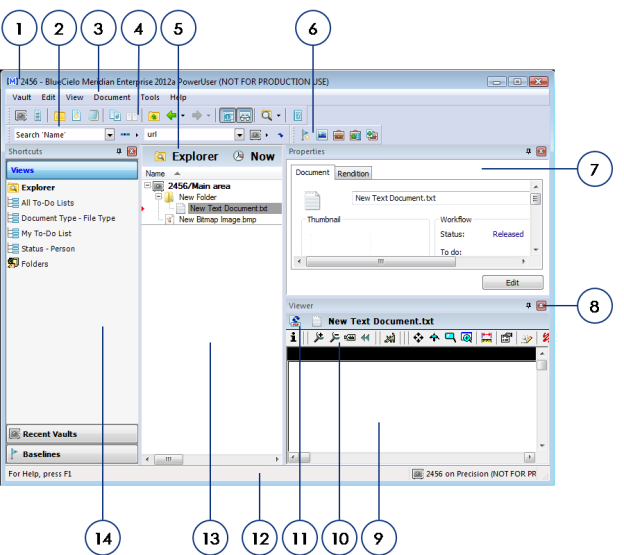
To start Meridian, click the appropriate icon on your desktop:

For information on starting the desktop applications with optional command-line arguments, see Understanding the command-line arguments.
The following figure identifies the various areas of the application window.

The following table describes each area of the application window.
| Number | Name | Description |
|---|---|---|
|
1 |
Title bar |
Contains the name of the current vault. |
|
2 |
Find toolbar |
Common search tools. May be moved, docked, and hidden. |
|
3 |
Menu bar |
Context-sensitive menus of Meridian Enterprise commands. May be moved and docked. |
|
4 |
Main toolbar |
Buttons for frequently used commands. May be moved, docked, and hidden. |
|
5 |
Context bar |
Buttons for changing the current scope, Navigation view, |
|
6 |
Manager toolbar |
Buttons for frequently used manager commands. May be moved, docked, and hidden. |
|
7 |
Properties pane |
Property values for the currently selected item. The number and names of property pages vary with the currently selected item. This pane may be hidden or shown by clicking the Show or hide properties button |
|
8 |
Viewer Close button |
Closes the viewer window. Click the Show or hide viewer button |
|
9 |
Viewer pane |
Displays the contents of the selected document |
|
10 |
Viewer toolbar |
Buttons for viewer tools. Different tools are available depending on the current file format and the current viewer. |
| 11 |
Show native/rendition button |
Click to toggle display in the viewer pane of the source document or its rendition. The button icon identifies the format of the rendition file. |
|
12 |
Status bar |
Displays the current vault name, AMFS (BlueCielo File System) mode, |
|
12 |
Navigation view |
One of various hierarchical views of the vault contents. Select another view from the Shortcuts pane or click the Navigation view button in the context bar. For information about manipulating Navigation views, see Working with Navigation views. |
|
13 |
Shortcuts pane |
Buttons for easy access to Navigation views, saved searches, baselines, |